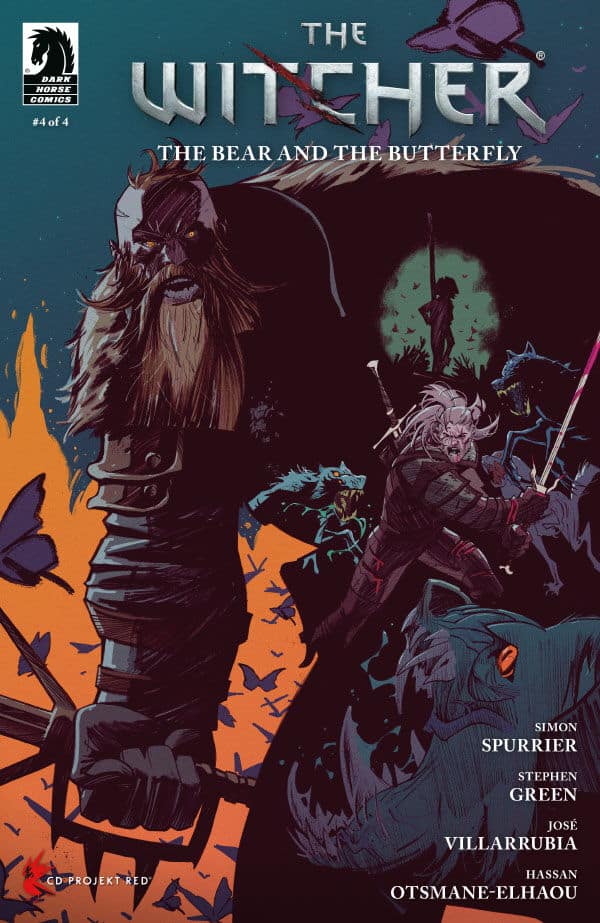The Witcher: The Bear and the Butterfly #4

Recap
There is a shadow of death hanging over the small town of Dol Gwyn. The White Wolf, Geralt of Rivia, has come to claim the bounty on a vampire terrorizing the region, aided by a young boy and a local woman, but what he finds is not a monster feasting on flesh but a wounded and scared creature hiding among its hunters after being framed for murder out of the jealousy and arrogance of another.
Review
The fourth and final installment of The Witcher: The Bear and the Butterfly is finally here, and it brings one of the best Witcher stories in recent memory to a bittersweet conclusion. So, where does this story stand in the grand Witcher mythos, and how does it line up along with some of the most well-written fantasy stories ever told across multiple mediums?
Geralt of Rivia is not an easy character to write. Despite what many would assume is simply making him brood and hunt monsters for the highest price he can fetch, the White Wolf has layers upon layers of substance constituted by unresolved, complex emotional conflicts and deep psychological scars around his life as a Witcher, his love for a complicated sorceress, and his role as a father to the most powerful girl ever born.
Geralt is the product of both his life and the people in it. Somehow, Simon Spurrier (The Flash) brings out each and every one of his layers in just four issues revolving around a story that includes none of Geralt’s usual supporting cast and in a location never before seen in the Witcher franchise. Instead, Spurrier invokes a juxtaposition between what others would typically call a “monster” and what a monster actually is, using this messy backdrop as a way to bring out Geralt’s inner qualities.
Spurrier’s characterization of Geralt is flawless. He is the same gruff, no-nonsense monster slayer as always but with the kindness and level-headedness born from the job of fatherhood and a life of needless tragedy. The principal side characters of Mot and Tila are also both fantastic in their own right and serve as monster and human personifications of the Witcher franchise’s specialty of using your own assumptions against you. Even the antagonist of the finale, who’s still never given a real name, is well characterized as selfish and power hungry without veering on archetype. They are a self-centered murderer whose actions lead to nothing but more of the same in a world that could do with a little less of its cruelty and suspicion.
Stephen Green’s (Sea of Stars) artwork manages to elevate Spurrier’s well-penned world and masterfully written characters to even greater heights, with the colors by José Villarrubia (Fantastic Four: 1234) bringing out the grime of combat, the spartan conditions of the poor townspeople, and the horror in the haunted life of a being others would call a monster despite just wanting to live and love.
Final Thoughts
The Witcher: The Bear and the Butterfly #4 (of 4) once again proves that "monster" isn’t always a clear term by taking all of your assumptions and using them against you. With a storyline that is as complex and morally ambiguous as one might expect of the golden age of Witcher books and games, and artwork that tells a story within a story by leveraging dialogue against clues hidden inside the pages themselves, The Bear and the Butterfly is one of The Witcher’s best tales, among a sea of legendary stories, quest lines, and characters.
If you are a fan of The Witcher, whether it be from the original books by Andrzej Sapkowski, the video games from CD Projekt Red, or the television series from Netflix, The Witcher: The Bear and the Butterfly should be perfectly aligned with your expectations from the setting and characters. My recommendation: a fantastic conclusion to a four-part comic series for Witcher fans of all kinds.
The Witcher: The Bear and the Butterfly #4 – A Monster Called Love
- Writing - 10/1010/10
- Storyline - 10/1010/10
- Art - 9/109/10
- Color - 9/109/10
- Cover Art - 9/109/10





